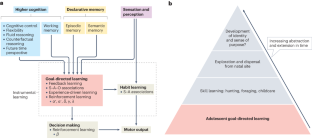Goal-directed learning in adolescence: neurocognitive development and contextual influences
IF 28.7
1区 医学
Q1 NEUROSCIENCES
引用次数: 0
Abstract
Adolescence is a time during which we transition to independence, explore new activities and begin pursuit of major life goals. Goal-directed learning, in which we learn to perform actions that enable us to obtain desired outcomes, is central to many of these processes. Currently, our understanding of goal-directed learning in adolescence is itself in a state of transition, with the scientific community grappling with inconsistent results. When we examine metrics of goal-directed learning through the second decade of life, we find that many studies agree there are steady gains in performance in the teenage years, but others report that adolescent goal-directed learning is already adult-like, and some find adolescents can outperform adults. To explain the current variability in results, sophisticated experimental designs are being applied to test learning in different contexts. There is also increasing recognition that individuals of different ages and in different states will draw on different neurocognitive systems to support goal-directed learning. Through adoption of more nuanced approaches, we can be better prepared to recognize and harness adolescent strengths and to decipher the purpose (or goals) of adolescence itself. During adolescence, we acquire skills and behavioural patterns that support our future survival through goal-directed learning. Wilbrecht and Davidow describe the neural and cognitive systems that support goal-directed learning in adolescence, as well as our growing understanding of the influence of context on this process.


青春期的目标导向学习:神经认知发展和环境影响。
青春期是我们向独立过渡、探索新活动和开始追求主要人生目标的时期。目标导向学习,即我们学习如何通过行动来获得理想的结果,是许多这些过程的核心。目前,我们对青春期目标导向学习的理解还处于过渡阶段,科学界也在努力解决结果不一致的问题。当我们研究人生第二个十年的目标导向学习指标时,我们发现许多研究都认为青少年时期的学习成绩会稳步提高,但也有一些研究报告称青少年的目标导向学习已经与成人无异,还有一些研究发现青少年的学习成绩可以超过成人。为了解释目前的结果差异,人们正在采用复杂的实验设计来测试不同情境下的学习情况。人们也越来越认识到,不同年龄和不同状态的个体会利用不同的神经认知系统来支持目标导向学习。通过采用更细致的方法,我们可以更好地认识和利用青少年的优势,并解读青春期本身的目的(或目标)。
本文章由计算机程序翻译,如有差异,请以英文原文为准。
求助全文
约1分钟内获得全文
求助全文
来源期刊

Nature Reviews Neuroscience
NEUROSCIENCES-
自引率
0.60%
发文量
104
期刊介绍:
Nature Reviews Neuroscience is a multidisciplinary journal that covers various fields within neuroscience, aiming to offer a comprehensive understanding of the structure and function of the central nervous system. Advances in molecular, developmental, and cognitive neuroscience, facilitated by powerful experimental techniques and theoretical approaches, have made enduring neurobiological questions more accessible. Nature Reviews Neuroscience serves as a reliable and accessible resource, addressing the breadth and depth of modern neuroscience. It acts as an authoritative and engaging reference for scientists interested in all aspects of neuroscience.
 求助内容:
求助内容: 应助结果提醒方式:
应助结果提醒方式:


